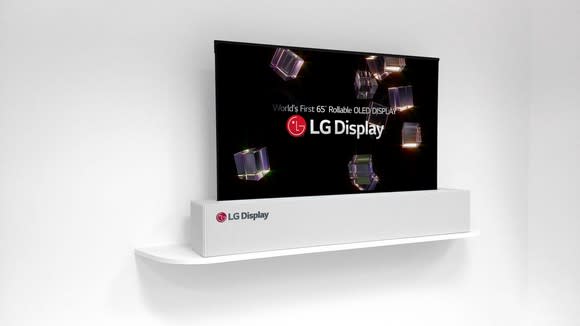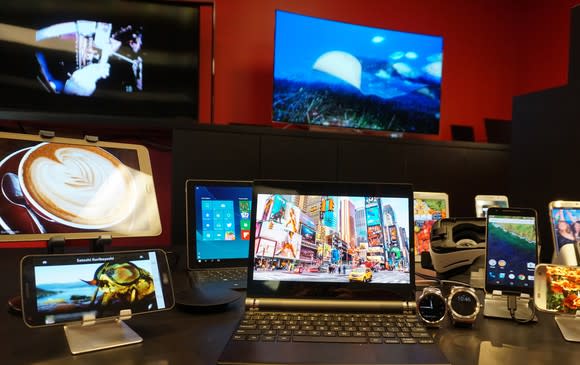3 Top Mid-Cap Stocks to Buy in July
With investing, large-cap stocks get all the press for stability, while small-cap stocks get all the glory for explosive growth -- leaving mid-caps as the underappreciated middle children of the shareholder set. That's too bad, because these companies, which are generally defined as having a market value between $2 billion and $10 billion, have been quietly but significantly outperforming both their larger and smaller peers for more than two decades.
That makes sense, since these companies have survived their early days, and many are on the way to becoming the big winners of tomorrow.
With a multitude of midsized businesses in the investing universe to choose from, we asked three Motley Fool investors to choose mid-cap stocks they believe have the best immediate prospects. Read on to find out why they chose LG Display (NYSE: LPL), Universal Display (NASDAQ: OLED), and The Trade Desk (NASDAQ: TTD).

Image source: Getty Images.
This extremely discounted pricing won't last long
Anders Bylund (LG Display): The LCD and OLED screen manufacturing arm of Korean technology giant LG works in a cyclical industry. Demand for the company's products will come and go as consumer markets around the world evolve. At the moment, LG Display's sales are trending down due to weak demand for smartphone displays. Market makers responded by taking LG Display's share price 16% lower over the last 30 days. Year to date, you're looking at a negative return of 36%.
You know that old expression, right? "What goes down must come up."
O.K., that's not exactly how the adage goes, but sometimes it applies to cyclical businesses like LG Display. As it turns out, some investors fear that LG Display may lose business to crosstown archrival Samsung Display when Apple makes OLED screens a common feature in the iPhones of 2019 and beyond.
The two companies already split Apple's LCD screen contracts, and Cupertino's supply chain also includes smaller players such as Japan Display. But Samsung is reportedly the only OLED producer for the iPhone X, so LG Display's LCD role could become much less important to Apple over time. From this perspective, LG Display's sliding share prices make a lot of sense.

Image source: LG Display.
But the company is also one of the largest OLED screen builders in the world. Samsung may have been the early bird when it comes to OLED-based iPhone screens, but Apple is likely to adopt additional suppliers (almost certainly including LG Display) in the years ahead.
In fact, Korean tech industry paper DigiTimes just reported that LG Display will start sending OLED panels to Apple as early as the second half of 2018. That would be right here, right now. The volume of old-school LCD screens will be far larger than the new OLED relationship at first, but it's a start.
So this company is poised to make a full and rather quick recovery from its current doldrums. Meanwhile, LG Display's stock is on fire sale at just 6.7 times trailing earnings, or 2.2 times EBITDA profits. That's a no-brainer of a buy in my book.
OLED hits a speed bump
Nicholas Rossolillo (Universal Display): Shares of the OLED-screen patent holder and supplies seller have taken investors on an unpleasant ride this year. After Apple's iPhone X and its cool OLED screen seemingly ushered in a new era in display technology, Universal Display's management called for a flat year of sales in 2018. The stock -- which had doubled a couple of times since the beginning of 2017 -- promptly lost half its value.
Since then, shares have been stuck in a volatile up-and-down limbo, susceptible to reports and speculation about if and how many new iPhones will have an OLED front when announced this fall. However, if Universal Display's projections transpire, the pain could be over soon. After a 22% drop in sales in the first quarter, growth is expected to pick up again in the back half of the year and into 2019.

Image source: Universal Display.
Producers of finished products like LG Display and Samsung are investing in new manufacturing capacity and decreasing costs, which could speed up the adoption of the technology. Both expect shipments of their OLED high-definition TVs to dramatically increase this year compared with last. Competing options like microLED are being developed but are still years away from being ready. That gives OLED some time to build up to the primary option in electronic displays.
The real upshot is that no matter what the application for OLED -- be it TVs, smartphones, automobiles, etc. -- Universal Display wins. With a fair amount of pessimism already priced into the stock, now could be a great time to pick up shares before new electronic devices are released this fall in preparation for the holiday shopping season.
Advertising 2.0
Danny Vena (The Trade Desk): While industry stalwarts like Facebook and Alphabet's Google together control the majority of digital advertising, that doesn't mean there isn't room for others to succeed. That's where an upstart like The Trade Desk comes in.
The company's digital and programmatic advertising platform uses computer programs to simplify ad buying in real time. And it spreads those purchases across numerous channels, placing ads where they will most likely be successful. This focus on technology has allowed the company to carve out a niche and siphon market share from the biggest players. The Trade Desk offers a number of tools that provide advertisers with the data-driven insights necessary to help companies better manage their campaigns across multiple channels and devices, thereby optimizing their ad spending.

Image source: The Trade Desk.
These innovations have led to explosive growth for the company. In its most recent quarter, The Trade Desk generated revenue that increased 61% year over year, while earnings per share grew 82% compared to the prior-year quarter. Those impressive gains were driven by solid growth across all the company's key channels, including mobile, video, audio, and connected TV. Most notable were the increases in mobile video ads, which jumped 160% year over year, and connected-TV ads, which skyrocketed more than 2,000% year over year. This has also led to impressive customer retention rates, exceeding 95% for 18 quarters running.
With the ongoing trend that is further blurring the lines between television and the internet, The Trade Desk has a massive and growing runway. I think its recent gains are just the beginning, making The Trade Desk the perfect mid-cap stock to buy in July.
More From The Motley Fool
Suzanne Frey, an executive at Alphabet, is a member of The Motley Fool's board of directors. Anders Bylund owns shares of Alphabet (A shares) and Universal Display. Danny Vena owns shares of Alphabet (A shares), Apple, Facebook, The Trade Desk, and Universal Display. Nicholas Rossolillo owns shares of Alphabet (A shares), Alphabet (C shares), Apple, Facebook, and Universal Display. The Motley Fool owns shares of and recommends Alphabet (A shares), Alphabet (C shares), Apple, Facebook, The Trade Desk, and Universal Display. The Motley Fool has the following options: long January 2020 $150 calls on Apple and short January 2020 $155 calls on Apple. The Motley Fool has a disclosure policy.

 Yahoo Finance
Yahoo Finance 